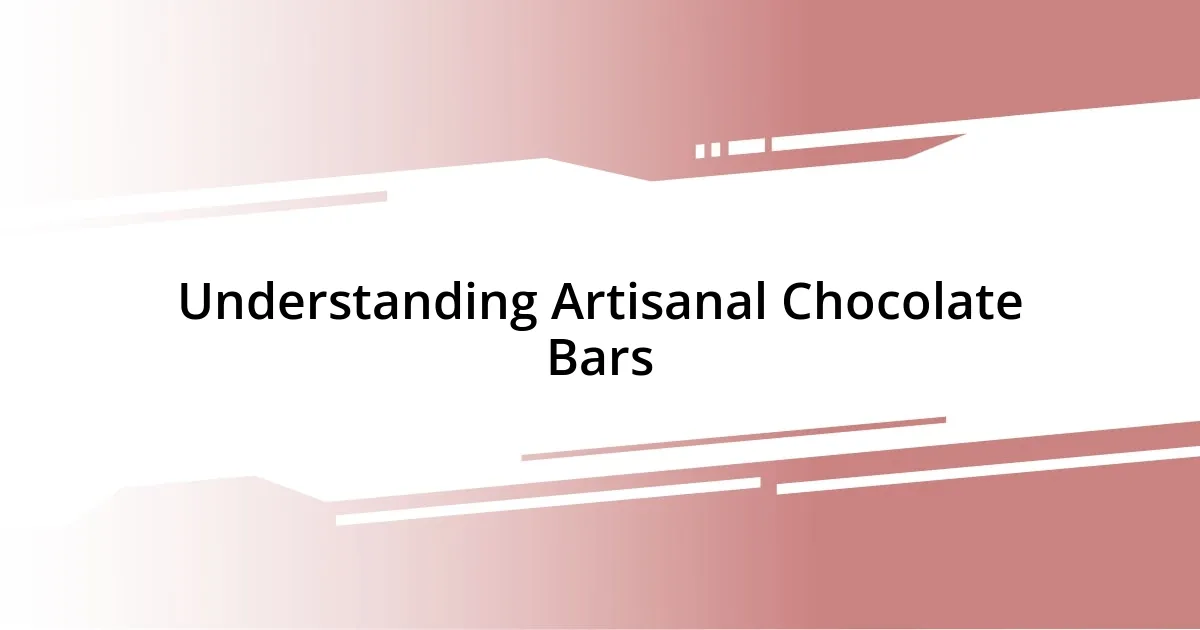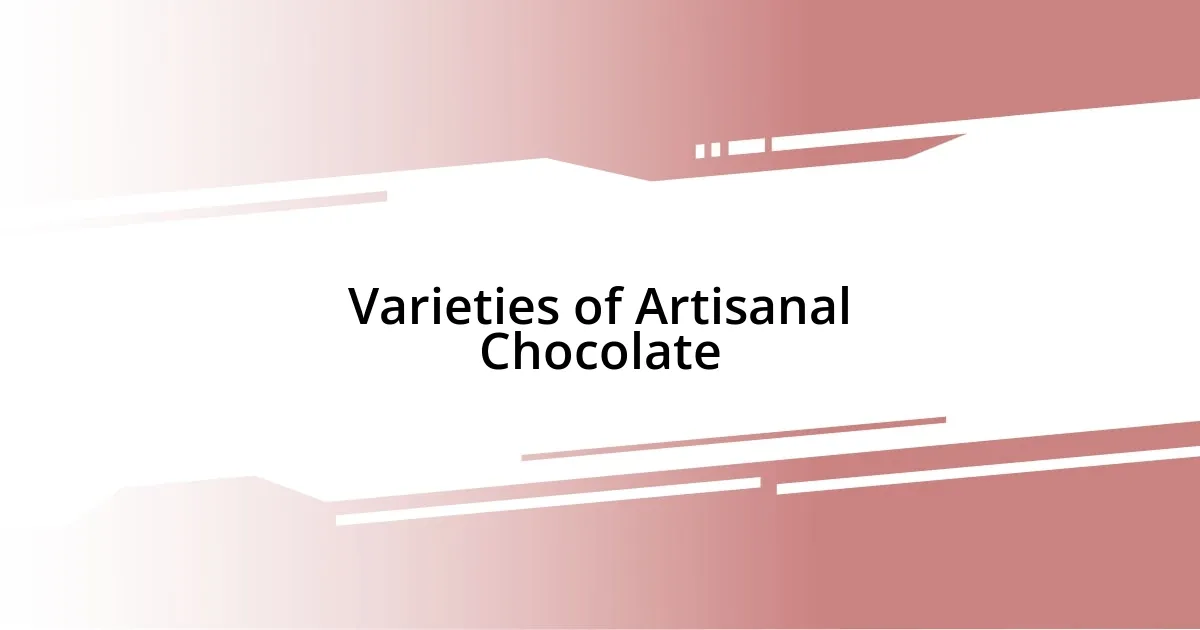Key takeaways:
- Artisanal chocolate bars offer unique flavors influenced by cacao origin and maker stories, promoting sustainable practices.
- The chocolate-making process involves several key steps: harvesting, fermentation, drying, roasting, winnowing, conching, tempering, and molding.
- There are various types of artisanal chocolate including single-origin, blended, and flavor-infused, catering to diverse taste preferences.
- Dark chocolate provides health benefits such as improved heart health, stress relief, and enhanced cognitive function due to its high cacao content.

Understanding Artisanal Chocolate Bars
Artisanal chocolate bars are crafted with a level of care and attention that transcends mass production. When I first bit into a rich, single-origin bar, I was amazed by the complexity of flavors dancing on my palate – notes of caramel, fruit, and even a hint of spice. Have you ever considered how the bean’s origin can influence its taste profile? It’s a revelation that adds depth to every chocolate experience.
What I love most about artisanal chocolate is the story behind each bar. Take, for example, a chocolate maker who sources beans from a small cooperative in Ecuador. Each purchase supports farmers dedicated to sustainable practices and community development. When I learned about the journey of these beans, it deepened my appreciation; it felt like I was enjoying a piece of their passion and labor with every bite.
Finally, the process of artisanal chocolate making often involves unique techniques and flavors, such as infusing herbs or using local ingredients. I still remember the first time I tried a dark chocolate bar blended with sea salt and caramel – it was so unexpected yet perfect! It makes you wonder: how many different flavor combinations are out there just waiting to be discovered? With each artisanal bar, there’s an adventure waiting to unfold.

The Process of Making Chocolate
The journey of making chocolate begins far from the factory floor. It all starts with cacao beans, which are harvested from cacao pods. Once the beans are collected, they undergo a fermentation process that develops their flavor. I remember the first time I visited a cacao farm in the lush hills of Peru; the air was filled with the sweet, fruity aroma of fermenting beans, and I could feel the rich history of chocolate in that moment.
There are several key steps in transforming cacao beans into chocolate bars:
- Harvesting: Cacao pods are cut from the trees, and the beans are extracted.
- Fermentation: The beans are placed in boxes or covered with banana leaves for several days to develop their flavor.
- Drying: Beans are spread out under the sun to reduce moisture content.
- Roasting: The dried beans are roasted to enhance their flavor, a process that always feels like a controlled alchemy.
- Winnowing: The roasted beans are cracked open, and the shells are removed to obtain the nibs.
- Conching: The nibs are ground into a liquid, allowing the flavors to meld beautifully over time, which is a process that’s truly mesmerizing to witness.
- Tempering: This is where the chocolate’s texture is perfected, ensuring it has that satisfying snap when you break a piece.
- Molding: Finally, the chocolate is poured into molds and cooled, ready to tantalize your taste buds.
Each stage is a careful balancing act of tradition and creativity that results in the artisanal chocolate we cherish. Every step feels like a piece of a greater puzzle, culminating in that magical moment when you take your first bite.

Varieties of Artisanal Chocolate
Artisanal chocolate comes in an incredible array of varieties, each offering a unique experience. For instance, single-origin chocolate is like a passport that takes you to the region where the cacao is grown – imagine a dark chocolate from Madagascar that bursts with fruity notes. I still remember tasting a bar infused with the essence of its tropical climate; it was like having a conversation with the land itself. In contrast, blended chocolates mix beans from different origins, creating a harmonious balance of flavors that can be equally enchanting.
Then, there are the flavor-infused artisanal chocolates that often surprise your senses. I recently tried a chocolate bar that was infused with lavender, and the gentle floral notes elevated the experience to a whole new level. It’s fascinating to think about how chocolate makers experiment with spices, herbs, and even savory elements. Each infusion I encounter feels like a delicious testament to creativity in chocolate-making.
Finally, we cannot forget about the types of chocolate itself: dark, milk, and white. Dark chocolate is rich and intense, often featuring higher cacao content, lending to its deep flavors. Milk chocolate, on the other hand, has a creamier texture and sweetness that appeals to many. And then there’s white chocolate, which, despite not containing cacao solids, offers a buttery sweetness that can be blissful. Each type invites you to savor its distinct character, which only adds to the richness of the artisanal chocolate world.
| Variety | Description |
|---|---|
| Single-Origin | Chocolate made from cacao beans sourced from a specific region, showcasing unique flavor profiles. |
| Blended | A mixture of cacao beans from various locations, creating a balanced flavor experience. |
| Flavor-Infused | Chocolate infused with herbs, spices, or other elements, resulting in unexpected taste combinations. |
| Dark | Rich chocolate with high cacao content, offering intense flavors. |
| Milk | Creamier chocolate with added dairy, known for its sweetness. |
| White | Chocolate without cacao solids, offering a buttery, sweet taste. |

Pairing Chocolate with Other Flavors
Pairing chocolate with other flavors can elevate your tasting experience to remarkable heights. I remember savoring a rich dark chocolate paired with a sprinkle of sea salt, where the salt accentuated the chocolate’s deep notes, creating a symphony of flavors. It’s fascinating how a simple addition can transform the entire experience; have you ever tried pairing chocolate with something unexpected, like chili or rosemary? The complexity that emerges is exhilarating.
One of my favorite combinations is chocolate with fruit. The first time I tried chocolate-covered strawberries, I was taken aback by how the tartness of the berry complemented the smooth richness of chocolate. I’ve even experimented with chocolate and citrus, like pairing orange zest with dark chocolate. Each bite was a delightful contrast that danced on my palate. It’s these combinations that remind me of the playful nature of chocolate and how it can surprise us in the most beautiful ways.
Additionally, I’ve found that incorporating nuts adds a lovely crunch and flavor depth to chocolate. Just last week, I enjoyed a bar with almonds, where their nutty richness harmonized wonderfully with the chocolate’s sweetness. It made me think: what flavor pairing have you discovered that surprised you? The world of chocolate is so vast, and the journey of exploration within it is just as rewarding as the destination.

Health Benefits of Dark Chocolate
Dark chocolate is not just indulgent; it’s brimming with health benefits that can enhance your well-being. For instance, the high cacao content in dark chocolate translates to a wealth of antioxidants called flavonoids. These compounds are known to improve heart health by reducing blood pressure and increasing blood flow. It’s remarkable how something so delicious can actually support cardiovascular health—who knew treating yourself could be this beneficial?
In my experience, savoring dark chocolate can also elevate mood and lower stress levels. When I indulge in a couple of squares after a long day, I can feel the tension dissipate. This isn’t just my imagination; science supports that the compounds in dark chocolate can stimulate the production of endorphins, the so-called “feel-good” hormones. Don’t you feel a little happier when you enjoy something you love? It’s incredible how dark chocolate can act as a balm for our busy lives.
Moreover, I’ve discovered that choosing dark chocolate, particularly with a cacao percentage of 70% or higher, can assist in maintaining cognitive function. There’s research suggesting that it might even help with memory improvement. Just the other day, while enjoying a rich dark chocolate with hints of coffee, I couldn’t help but feel sharper and more focused while working on my writing. Isn’t it amazing that a small piece of chocolate can offer so much? It’s a delicious reminder that treating ourselves can also mean taking care of our health.

Where to Buy Quality Chocolate
Finding quality chocolate can be a delightful adventure. I often stroll through local artisan shops or farmers’ markets, where the vibrant displays of handmade bars catch my eye. There’s something special about meeting the chocolatiers, hearing their stories, and tasting samples that you simply don’t get from a regular grocery store. Have you ever tasted a chocolate bar and felt an immediate sense of connection with the maker? It’s those personal touches that make indulging in artisan chocolate truly worthwhile.
Online shopping has also opened up a world of artisanal chocolates. I love browsing websites that specialize in small-batch or fair-trade options, usually with compelling backstories about the sourcing of their cacao. One time, I ordered a selection from a boutique chocolatier in another state, and it felt like a surprise gift to myself. The bars arrived beautifully packaged, and each bite transported me to their cocoa farms. Have you explored chocolates from different regions? Each location has its unique flavor profiles based on its terroir, much like fine wines!
Don’t overlook local gourmet grocery stores either; many curate impressive selections of quality chocolates. When I last visited my neighborhood gourmet store, I uncovered a hidden gem: a rich, creamy chocolate infused with lavender. The moment I tasted it, I was swept away by how the floral notes complemented the chocolate’s decadence. This experience reminded me that quality can often be found in unexpected places. Isn’t it exhilarating to discover that perfect chocolate bar just waiting to be tasted?














